

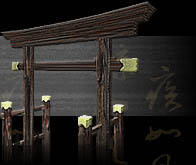
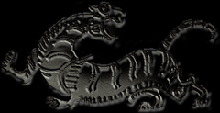
![]() In order to function, every army needs to be organized. Usually this means that a few skilled individuals make the decisions, which are then carried out by their more numerous underlings. This is called Chain of Command. Takeda's Chain of Command is as follows:
In order to function, every army needs to be organized. Usually this means that a few skilled individuals make the decisions, which are then carried out by their more numerous underlings. This is called Chain of Command. Takeda's Chain of Command is as follows:
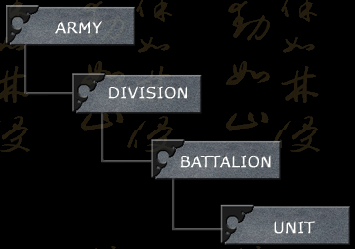
The Army:
![]() An army in Takeda can be quite big. Each army on the battlefield can have nearly five hundred men at any given time. However, trying to control this many units individually can be a very daunting task. This is the whole reason for having a Chain of Command - so the commander of the army (in this case you, the player) does not need to walk around and tell each and every soldier what to do. For this reason, the army is broken down into two kinds of groups: Divisions, and Battalions.
An army in Takeda can be quite big. Each army on the battlefield can have nearly five hundred men at any given time. However, trying to control this many units individually can be a very daunting task. This is the whole reason for having a Chain of Command - so the commander of the army (in this case you, the player) does not need to walk around and tell each and every soldier what to do. For this reason, the army is broken down into two kinds of groups: Divisions, and Battalions.
The Division:
![]() Divisions are the main element of the army, and are the primary part of the army that the player has direct control over. A division is a battle group consisting of one to four battalions - about forty men.
Divisions are the main element of the army, and are the primary part of the army that the player has direct control over. A division is a battle group consisting of one to four battalions - about forty men.
After receiving an order, a division will dispatch instructions to its subordinate battalions. The division structure ensures that individual battalions are able to work together efficiently. When two or three battalions are engaged in combat, a division is likely to ask the remaining unengaged battalions to join the battle and temporarily abandon their current assignments.
Each army can have up to twelve divisions on the battlefield at one time.

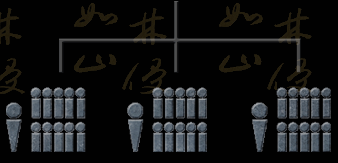
![]() The battalion is the actual combat group on the battlefield - a group of up to ten men, including a commanding officer. A battalion receives orders from its division, and then has its men carry out those orders to the best of their ability. Because battle conditions can be constantly changing , the battalion has some freedom in making decisions, This means that a battalion will not always blindly carry out orders, but will attack, defend, regroup, and take cover, as is most appropriate to the situation.
The battalion is the actual combat group on the battlefield - a group of up to ten men, including a commanding officer. A battalion receives orders from its division, and then has its men carry out those orders to the best of their ability. Because battle conditions can be constantly changing , the battalion has some freedom in making decisions, This means that a battalion will not always blindly carry out orders, but will attack, defend, regroup, and take cover, as is most appropriate to the situation.
Support Battalion
11st Battalion
2nd Battalion
![]() The officer is the leader of an army, skilled in strategy and directing troops. Officers form the key links in the Chain of Command - orders pass through the ranks of the officers, until finally they translate into the actions of individual soldiers on the field. As a player, it is important to realize this process, since the soldiers actually listen to their commanding officer, not directly to you. Although you tell the officers what to do, it is the officers who tell the soldiers what to do. Just as in real life, sometimes the man in the field knows more about his immediate situation than his boss, and must act as he feels is best in order to get the job done.
The officer is the leader of an army, skilled in strategy and directing troops. Officers form the key links in the Chain of Command - orders pass through the ranks of the officers, until finally they translate into the actions of individual soldiers on the field. As a player, it is important to realize this process, since the soldiers actually listen to their commanding officer, not directly to you. Although you tell the officers what to do, it is the officers who tell the soldiers what to do. Just as in real life, sometimes the man in the field knows more about his immediate situation than his boss, and must act as he feels is best in order to get the job done.
Remember, your officers may not always obey your commands explicitly. Officers are human beings, and are subject to the same emotions as their men. This means that they can sometimes be headstrong when thirsty for blood, or fearful and cowardly when out numbered by the enemy.
Soldiers rely very heavily on their officers - they depend on them to tell them what to do. Losing an officer in combat can have a devastating effect on the moral of his men.
![]() The marshall is in charge of the entire army. Although the marshall commands his own division, these men usually remain near the rear line with the reserve forces, attacking only when engaged or in extreme situations. From this position, the Marshall is able to see the entire situation of the battle and tell the army what to do. The presence of the marshall has a big impact on the army's morale - if he is killed, the entire army will probably retreat.
The marshall is in charge of the entire army. Although the marshall commands his own division, these men usually remain near the rear line with the reserve forces, attacking only when engaged or in extreme situations. From this position, the Marshall is able to see the entire situation of the battle and tell the army what to do. The presence of the marshall has a big impact on the army's morale - if he is killed, the entire army will probably retreat.

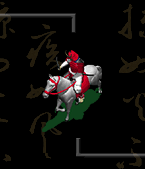
![]() A general is the leader of a single division. The general leads one battalion in the division, while the remainder is led by captains under the general's command. In Takeda, generals recruit their own men, and have their own shares of horses, rifles and supplies. In campaign games, when generals recruit captains, they keep them at all times. Generals can have as many captains as he can afford but can only take three into battle at a time. When a general dies in a campaign, one of his captains will be promoted as his successor.
A general is the leader of a single division. The general leads one battalion in the division, while the remainder is led by captains under the general's command. In Takeda, generals recruit their own men, and have their own shares of horses, rifles and supplies. In campaign games, when generals recruit captains, they keep them at all times. Generals can have as many captains as he can afford but can only take three into battle at a time. When a general dies in a campaign, one of his captains will be promoted as his successor.
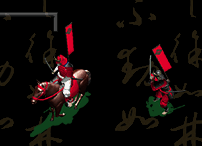
![]() Captains are the subordinates of generals. These men command battalions within their general's division. Captains serve and fight only for their own general; they are never transferred to other divisions.
Captains are the subordinates of generals. These men command battalions within their general's division. Captains serve and fight only for their own general; they are never transferred to other divisions.